
HMAS Sydney (R17/A214/P214/L134) was a Majestic-class light aircraft carrier operated by the Royal Australian Navy (RAN). She was built for the Royal Navy and was launched as HMS Terrible (93) in 1944, but was not completed before the end of World War II. The carrier was sold to Australia in 1947, completed, and commissioned into the RAN as Sydney in 1948.

USS Admiral W. S. Sims (AP-127) was a transport in the United States Navy. She was later renamed USNS General William O. Darby (T-AP-127). Later her name was struck and she was known simply by her hull number. In 1981, she was reclassified as IX-510.

USS Merrick (AKA-97/LKA-97) was an Andromeda-class attack cargo ship named after Merrick County, Nebraska.
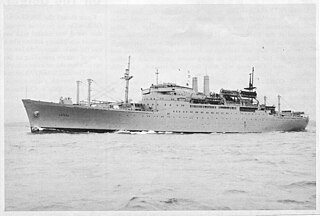
USNS Geiger (T-AP-197)/USTS Bay State IV was a transport ship in the United States Navy. She was named after General Roy Geiger, who, from July 1945 to November 1946, commanded Marine Force, Pacific Fleet.

USS Admiral Hugh Rodman (AP-126) was an Admiral W. S. Benson-class transport: Laid down, 24 April 1944, as a Maritime Commission type (P2-SE2-R1) hull, under Maritime Commission contract,, at Bethlehem Shipbuilding Corporation, Alameda, California; launched on 25 February 1945; commissioned as the USS Admiral Hugh Rodman (AP-126), 7 July 1945, decommissioned on 14 May 1946, at New York; transferred to the U.S. Army Transportation Service in May 1946; commissioned USAT General Maurice Rose on 1 August 1946; reacquired by the U.S. Navy and assigned to the Military Sea Transport Service (MSTS); placed in service as USNS General Maurice Rose (T-AP-126) on 1 March 1950.
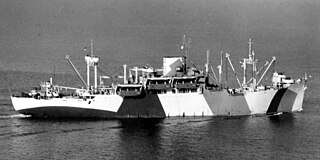
USS Thomas Jefferson (APA-30), serving from 1 May 1942 until 18 July 1955, was a transport and then reclassified on 1 February 1943 as a President Jackson-class attack transport. She was laid down under Maritime Commission contract as President Garfield on 5 February 1940 at Newport News, Virginia, by the Newport News Shipbuilding & Drydock Company for the American President Lines. The ship was launched on 20 November 1940, sponsored by Miss Eugenia Merrill. President Garfield was completed 26 March 1941 and acquired by the War Shipping Administration (WSA) 29 November 1941 with American President Lines, the WSA agent, operating the ship as a troop transport. On 1 May 1942 the United States Navy purchased the ship and commissioned her USS Thomas Jefferson on 31 August 1942.

USNS General Hoyt S. Vandenberg (T-AGM-10) was a General G. O. Squier-class transport ship in the United States Navy in World War II named in honor of U.S. Army Chief of Engineers Harry Taylor. She served for a time as army transport USAT General Harry Taylor, and was reacquired by the navy in 1950 as USNS General Harry Taylor (T-AP-145).

USS General LeRoy Eltinge (AP-154) was a General G. O. Squier-class transport ship for the US Navy in World War II. She was named in honor of US Army general LeRoy Eltinge. She was transferred to the US Army as USAT General LeRoy Eltinge in 1946. On 20 July 1950 she was transferred to the Military Sea Transportation Service (MSTS) as USNS General LeRoy Eltinge (T-AP-154). She was later sold for commercial use and operated under the names SS Robert E. Lee and SS Robert Toombs, before being scrapped in 1980.

USS General E. T. Collins (AP-147) was a General G. O. Squier-class transport ship for the U.S. Navy in World War II. She was named in honor of U.S. Army general Edgar Thomas Collins. She was transferred to the U.S. Army as USAT General E. T. Collins in 1946. On 1 March 1950 she was transferred to the Military Sea Transportation Service (MSTS) as USNS General E. T. Collins (T-AP-147). She was later sold for commercial operation under the name SS New Orleans, before being eventually scrapped.

USS Menard (APA-201) was a Haskell-class attack transport that saw service with the US Navy in World War II, the Korean War and Vietnam War.

USS General John Pope (AP-110) was a troop transport that served with the United States Navy in World War II. After the war she was transferred to the Army and redesignated USAT General John Pope. She later served in the Korean and Vietnam Wars as a civilian-manned Military Sea Transportation Service vessel, as USNS General John Pope (T-AP-110).

USS General W. A. Mann (AP-112) was a troop transport that served with the United States Navy in World War II, the Korean War and the Vietnam War.

USS General W. H. Gordon (AP-117) was a troop transport that served with the United States Navy in World War II. After the war, she was transferred to the US Army and served as USAT General W. H. Gordon. With the outbreak of the Korean War, she was reacquired by the Navy as a civilian-manned Military Sea Transportation Service (MSTS) vessel, and redesignated USNS General W. H. Gordon (T-AP-117). She served again under the same designation in the Vietnam War.
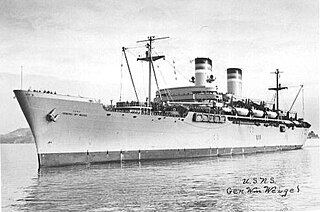
USS General William Weigel (AP-119) was a troopship that served with the United States Navy in World War II. After the war, she was acquired by the US Army and became USAT General William Weigel. On the outbreak of the Korean War, she was transferred to the Military Sea Transportation Service (MSTS) and designated USNS General William Weigel (T-AP-119), a designation she retained for her later service in the Vietnam War.
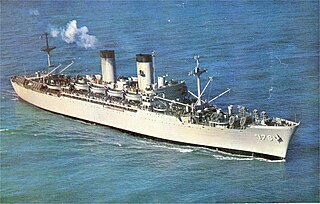
USS General J. C. Breckinridge (AP-176) was a troopship that served with the United States Navy in World War II, the Korean War and the Vietnam War. In October 1949 she was redesignated T-AP-176 but retained her Navy crew. Her namesake was United States Marine Corps Lieutenant General James Carson Breckinridge (1877-1942), who was the grandson of John Cabell Breckinridge, who served as Vice President of the United States from 1857 to 1861.

USNS Aiken Victory (T-AP-188) was a Victory ship-based troop transport that served with the United States Army Transport Service during both World War II and the Korean War. She was one of a class of 84 dedicated troop transports.
SS Greenville Victory was a cargo Victory ship built in 1944, during World War II under the Emergency Shipbuilding program. The ship’s United States Maritime Commission designation was VC2-S-AP3, hull number 18 (V-18). Post-war she was acquired by the U.S. Army and renamed as USAT Greenville Victory. She was acquired by the U.S. Navy in 1950, renamed USNS Greenville Victory (T-AK-237) and assigned to the Military Sea Transportation Service (MSTS) who operated her safely through the Korean War and Vietnam War campaigns. She was the lead ship in her class of 9 ships that were transferred to the MSTS in 1950. She returned home with two battle stars to her credit and was struck in 1987.

USS Tioga County (LST-1158), previously USS LST-1158, was a United States Navy landing ship tank (LST) in commission from 1953 to 1970, and which then saw non-commissioned Military Sealift Command service as USNS Tioga County (T-LST-1158) from 1972 to 1973.
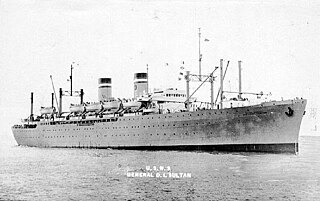
USS Admiral W. S. Benson (AP-120) began as an unnamed transport, AP-120, that was laid down on 10 December 1942 at Alameda, California by the Bethlehem-Alameda Shipbuilding Corp., under a Maritime Commission contract. She was named Admiral W. S. Benson (AP-120) on 20 October 1943 and launched on 22 November 1943; sponsored by Miss Dorothy Lucille Benson, granddaughter of the late Admiral William S. Benson. She was accepted from the Maritime Commission on 23 August 1944 and commissioned the same day.
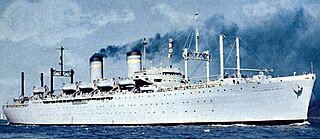
USS Admiral R. E. Coontz (AP-122) was an Admiral W. S. Benson-class transport built for the U.S. Navy during World War II. She was laid down under a Maritime Commission contract on 15 January 1943 at Alameda, California, by the Bethlehem Steel Corp., and launched on 22 April 1944. She was sponsored by Mrs. Edwin Kokko, daughter of Admiral Coontz, and commissioned on 21 November 1944, Capt. Montford R. Tawes, USNR, in command.





















